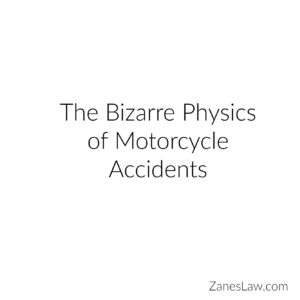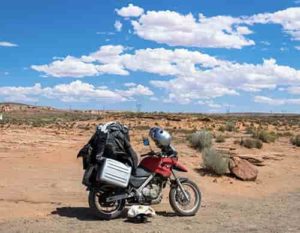![]() Contact Us 866-499-8989
Contact Us 866-499-8989
Is Lane Splitting Legal In Arizona?
- What Is Lane Splitting?
- Benefits of Lane Splitting
- Lane Splitting Isn't the Same as Lane Filtering
- Lane Filtering Is Legal in Four States in the US
- Where Is Lane Splitting Legal in the US?
- Arizona's New ‘Lane Filtering' Law
- Recovering Damages in a Lane Splitting Accident
- Contact Our Experienced Arizona Motorcycle Accident Attorneys
- Home
- FAQs
- Motorcycle Accidents
- Is Lane Splitting Legal In Arizona?
Lane splitting is not legal in Arizona. However, lane filtering has been legal in the Grand Canyon state since 2022. This legalization allows motorcyclists to weave in and out of traffic lanes to reach the head of the queue at stoplights. This new rule only happens during red lights and when all vehicles have stopped.
Two-wheeled motorcyclists, motorists, and all parties in between need to know how to accommodate lane filtering if they want to remain as safe as possible on Arizona roads. Unfortunately, motorcyclists operating two-wheeled motorcycles without proper care can cause dangerous accidents while filtering.
If you’re recovering from a lane filtering accident, consider getting in touch with a Phoenix motorcycle accident lawyer. An experienced lawyer can break down the complexities of your accident and help you outline your right to recovery under the law.
What Is Lane Splitting?
When two automobiles travel in the same direction, a motorcyclist may “split lanes” by riding between them. To ride on the white dashed line that separates lanes in the direction of travel, often known as “white-lining,” is legal.
Lane splitting is exclusively sanctioned by law in California. For instance, it is perfectly legal to bike or ride a motorcycle between lanes of traffic in Los Angeles, even if the traffic is going slowly on one of the city’s numerous roads.
Motorcyclists who lane filter or lane split must keep an eye on adjacent traffic lanes to keep themselves and other road users as safe as possible, especially in the face of significant traffic congestion. Interested parties can refer to Arizona law for updates on the 2022 approval of lane filtering.
For a free legal consultation, call 866-499-8989
Benefits of Lane Splitting
Using lane splitting has three positive effects:
- There is little risk involved. It has been shown that lane-splitting motorcyclists suffer much fewer injuries and are rear-ended far less often than other riders.
- There will be less congestion. Without lane splitting, Arizona motorcyclists take up as much room on the road as a vehicle. Motorcyclists can reduce congestion by splitting lanes.
- It helps keep motorcycles cooler. A motorcycle with an air-cooled engine should not be idled in traffic to prevent the engine from overheating.
If you sustained injuries in a rear-end collision in Arizona, contact our motorcycle accident lawyer in Arizona for legal representation. With our no-cost consultation, you can connect with our attorneys and discuss your case in-depth with no time constraints.
Other than lane splitting, another term that comes to light is lane filtering. Both lane filtering and splitting might seem similar, but they are different.
Lane Splitting Isn’t the Same as Lane Filtering
There are key differences between lane splitting and lane filtering. The American Motorcyclist Association breaks down the definition of lane splitting by describing the act as “riding a motorcycle between stopped motor vehicles to the front of the pack, typically at a signalized intersection.”
By contrast, lane filtering involves a motorcycle riding between two stationary or slowly moving vehicles rather than between two lanes of moving traffic going in the same direction. In the United States, lane splitting and filtering aren’t legal in all states but a select few.
Click to contact our personal injury lawyers today
Lane Filtering Is Legal in Four States in the US
Arizona, Hawaii, Montana, and Utah are the four states that enable lane filtering. Before visiting these states, you must familiarize yourself with the local regulations.
Connecticut, Maryland, Massachusetts, Missouri, Oregon, Texas, Virginia, and Washington are among the states proposing lane splitting and lane filtering legislation.
Complete a Free Case Evaluation form now
Where Is Lane Splitting Legal in the US?
Lane splitting is exclusively sanctioned by law in California. The law allows a motorcycle to safely and legally go at fast or moderate speeds between lanes of vehicles traveling in the same direction. In California, the DMV only gives three rules for motorcyclists to follow while lane splitting.
The rules are:
- Maintain a speed not more than ten mph faster than the posted speed limit.
- If the traffic speed around you is 30 miles per hour or higher, you shouldn’t get a lane split.
- Stay in your lane near the exit and entrance ramps to the motorway.
Any motorist who attempts to prevent a rider from splitting by physically intervening in the lane with their car or door is also against the law. It’s a breath of fresh air to lane split in California. Similar to California’s lane-splitting law, Arizona’s lane-filtering law also has some specifics to help people understand the law better.
Arizona’s New ‘Lane Filtering’ Law
Recently, Arizona passed legislation that outlaws “lane filtering ” strategies. As of September 24, motorcycle riders in Arizona are allowed to weave in and out of traffic up to a junction on congested roadways. This new rule makes lane filtering acceptable on two-way highways with a 45 mph speed limit.
Motorbikes making the bend have a 15 mph speed restriction. Lane filtering or lane splitting proponents claim it is beneficial because it allows motorcycle riders to save time and fuel.
Truck drivers, however, have expressed concern that bicyclists would attempt to maneuver past their vehicles.
The new law allows lane filtering in Arizona under the following conditions:
- When the maximum speed restriction in effect is less than 45 mph
- When filtering, the motorbike must go at a speed of at least 15 miles per hour.
- When the traffic comes to a complete halt
- At least a double lane separates both directions of traffic on the roadway.
Keep in mind that this regulation applies only to bikes with two wheels. A strict no-trike, no-sidecar policy is in effect, so no one is allowed stunt riding in Arizona. It’s an obvious concern given that three-wheeled bikes are often broader than two-wheeled ones.
Recovering Damages in a Lane Splitting Accident
Since lane splitting is prohibited by law in Arizona, anybody involved in an accident while doing so will be automatically considered negligent. However, even if you are at fault for the accident because you were lane splitting, that fact alone will not preclude you from being awarded damages.
Since Arizona follows the pure comparative blame concept, victims may seek compensation even if their carelessness also had a role in causing their injuries. Any damages will be reduced by the amount of guilt each party shares.
Contact Our Experienced Arizona Motorcycle Accident Attorneys
Can you lane split in Arizona? No. Regardless, you may have the right to take legal action against a liable party under Arizona law if you were injured in a motorcycle accident, whether or not you were lane splitting. However, when questions remain about whether or not the wounded biker was partially at fault for the crash, pursuing legal action might be difficult.
The Phoenix personal injury lawyers at Zanes Law have the experience to defend clients in motorcycle and other vehicle accident claims. Do you want a consultation with our motorcycle accident lawyers? Contact us today to schedule a free consultation.
Call or text 866-499-8989 or complete a
Free Case Evaluation form
 The Bizarre Physics of Motorcycle Accidents
The Bizarre Physics of Motorcycle Accidents The Bizarre Physics of Motorcycle Accidents Riding a motorcycle on today's highways, you have to ride in a very defensive manner, and it's helpful to understand the physics of motorcycle accidents.
 Zanes Settles a Motorcycle Accident for Over $400,000
Zanes Settles a Motorcycle Accident for Over $400,000 The legal team at Zanes Law is thrilled to announce its latest big win. In early February, we settled for $410,000 after our client’s motorcycle rear-ended another vehicle. The settlement
 5 Tips for Safely Riding Your Motorcycle this Summer
5 Tips for Safely Riding Your Motorcycle this Summer Nothing is better than hopping on your motorcycle and going for a ride on a nice summer day. But before you turn on the engine, it’s important to be sure that you understand how to stay safe. Here
 How Negligence Is Established in a Motorcycle Accident
How Negligence Is Established in a Motorcycle Accident After a motorcycle accident, both victims need to pay for their injuries and property damage, but who pays whom? In at-fault states like Arizona, the person who is more negligent pays. The law states
Tell us what happened…
Receive a Free, No-Obligation, Case Evaluation Now
